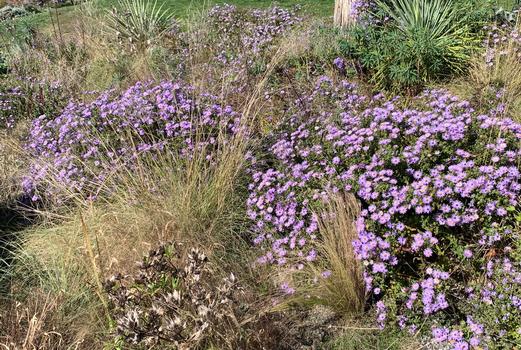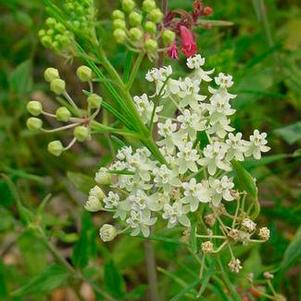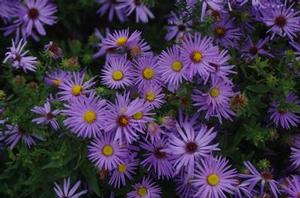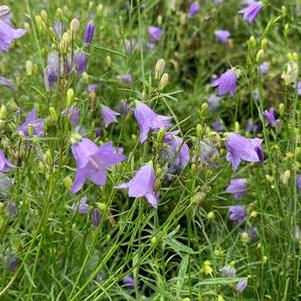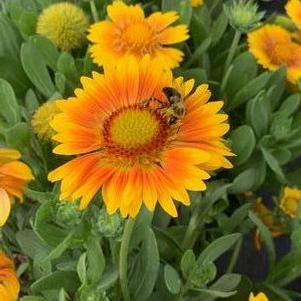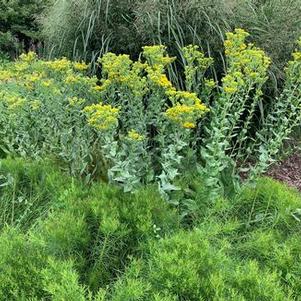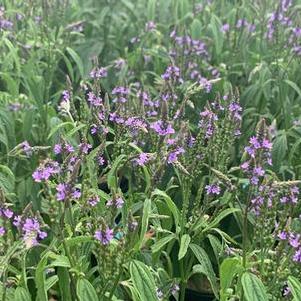Brawn & Beauty: Plants of the Badlands
Happy Veterans Day!
In honor of the brave folks who put their lives on the line to protect our vast and beautiful country, from the amber waves of grain to the purple mountain majesties, this week we’re doing something a little bit differently. Without the unwavering fortitude and valor of our Veterans, American citizens might not be able to enjoy some of their country’s most spectacular natural parks and landscapes, amongst other things. There’s a lot to celebrate this weekend - with November 10th marking the 45th anniversary of Badlands National Park’s official designation as a national park, we’re praising some of the special species that make up this diverse and ecologically critical habitat. Let’s start with some quick facts about the Badlands and what makes them so special.
In honor of the brave folks who put their lives on the line to protect our vast and beautiful country, from the amber waves of grain to the purple mountain majesties, this week we’re doing something a little bit differently. Without the unwavering fortitude and valor of our Veterans, American citizens might not be able to enjoy some of their country’s most spectacular natural parks and landscapes, amongst other things. There’s a lot to celebrate this weekend - with November 10th marking the 45th anniversary of Badlands National Park’s official designation as a national park, we’re praising some of the special species that make up this diverse and ecologically critical habitat. Let’s start with some quick facts about the Badlands and what makes them so special.
Where and what are the Badlands?
Badlands National Park is located in the southwestern corner of South Dakota, part of the northernmost region of the Great Plains, consisting of picturesque buttes, spires and pinnacles, as well as mixed-grass prairie ecosystems. Due to difficult terrain, lack of annual precipitation (usually no more than 16” per year, not including the average 12-24” of snowfall during winter), and general hardiness of the species that were able to thrive there, the Lakota people referred to this area as “mako sica”, meaning “bad lands”. 244,000 acres of undisturbed mixed-grass prairie habitat make up the official geographical layout of the National Park, although the actual “bad lands” extend as far as central North Dakota, along the western border of both of the Dakotas.
What lives there?
Maybe you’ve heard of the American Bison? Big, burly, brown critters with horns and hooves that almost went extinct in the late 1800/early 1900’s? They call the Badlands, which is part of the largest undisturbed swath of mixed grassland-prairie in the United States, home. Currently, there are approximately 1,200 American bison roaming the Badlands, a minute fraction of the 30 million that used to roam most of the American West. They share protected status with the black-footed ferret, one of the world’s most critically endangered mammals, which were reintroduced to Badlands National Park after having been thought extinct. The United States Geological Survey has reported 120 black-footed ferrets that now live and thrive in the Badlands, which is also home to preferred prey mammal of the black-footed ferret: prairie dogs. Prairie dogs seemingly have it tough over in the Badlands. When they’re not worrying about being scooped by a ferret, they have prairie rattlesnakes to keep an eye out for. Over 200 different bird species primarily native to North America have been documented in the Badlands, with close to 70 species establishing nesting sites within the limits of the Park.
Why is this region so important geologically and ecologically?
While mixed-grass prairie ecosystems make up much of the geographical layout of the United States, unfortunately, much of that habitat has become developed, disturbed, or utilized for industrial (read: nefarious) purposes. This has cut down drastically on the above animals’ ability to safely provide shelter and sustenance for future populations and has driven them out of their homes, which further impacts the availability of certain plant species that require these animals to continue their life cycles. Bison roll around on the soil surface to relieve skin irritation, in the process creating “wallows”, which are essentially shallow ditches that collect rainwater. This, as well as the natural grazing cycles of these massive animals, are two acts that alone are responsible for aiding the proliferation of biodiverse plant material. Meanwhile, prairie dogs construct underground burrows that help to aerate and aggregate the soil, making it much more forgiving for plant roots that otherwise need to push through cement-like, heavily droughted terra firma. The introductions of exotic and invasive plant species by homeowners and land developers have also impacted the sensitive biological balance between native plants and native fauna in the Badlands (but also, like, everywhere else, too). Luckily, the federal protection of the Badlands benefits our endemic faunal species and act as an ongoing case study for biologists, botanists, ecologists, and geologists (to name a few). An ever-evolving landscape, the Badlands is in a constant state of erosion, disappearing at a rate of 1 inch every 10,000 years – which, if you’re a rock, is pretty fast. If you intend on visiting (and you really should), you only have about 500,000 years left to plan your trip. Get to it!
How can we help?
While it’s difficult to help conserve the Badlands all the way out here on the East Coast, we can provide insight on what Badland-friendly plants can also be used to restore our own native grasslands and dry, full-sun shrublands. And, wowie, there really is no shortage of interesting native plants. Just because a habitat has a name like the “badlands”, doesn’t mean that there isn’t a broad diversity of forbs, graminoids, trees, and shrubs that are familiar to us here in the Mid-Atlantic.
We’ve compiled a helpful list of some local natives that are monitored and conserved within the Badlands that thrive in – surprise, surprise – very dry, rocky, full sun conditions this side of the Miss’ippi (that’s the Mississippi River, for you Northeasterners).
Achillea millefolium | yarrow (not currently available)
Asclepias speciosa | showy milkweed (1gal - qty 57)
Asclepias verticillata | butterfly weed (1gal - qty 35; future crop 300 1gal.)
Aster ericoides | heath aster (‘Bridal Veil’ 1gal - qty 15; ‘Snow Flurry’ 1gal - qty 163)
Aster oblongifolius | aromatic aster (not currently available)
Aster laevis (syn. Symphyotrichum laeve) | smooth aster (‘Bluebird’ 1gal - qty 132)
Bouteloua curtipendula | sideoats grama grass (1gal - qty 452)
Bouteloua gracilis | blue grama grass (1gal - qty 472)
Campanula rotundifolia | harebell bluebell (1gal - qty 268)
Celtis occidentalis | hackberry (Prairie Sentinel® 20gal - qty 16)
Dalea purpurea | purple prairie clover (future crop qty 200 1gal.)
Echinacea angustifolia | narrow-leaf coneflower (1gal - qty 89)
Gaillardia aristata | blanket flower (‘Arizona Apricot’ 1gal - qty 58; ‘Arizona Red Shades’ 1gal - qty 144)
Geum triflorum | prairie smoke (1gal - qty 359)
Juniperus horizontalis | creeping juniper (‘Andorra Compacta’ 3gal - qty 62; ‘Bar Harbor’ 3gal - qty 15; ‘Wiltoni’ 3gal - qty 9)
Juniperus virginiana | red cedar (‘Grey Owl’ 3gal - qty 32, ‘Taylor’ 15gal - qty 15; 25gal - qty 2)
Monarda fistulosa | Eastern bee balm (1gal - qty 75)
Panicum virgatum | switchgrass (1gal - qty 374 – check our website for all available cultivars!)
Rhus aromatica | fragrant sumac (‘Gro-Low’ 3gal - qty 516)
Schizachyrium scoparium | little blue stem (1gal - qty 622 – check our website for all available cultivars!)
Solidago rigida | stiff goldenrod (1gal - qty 184)
Verbena hastata | blue vervain (2gal - qty 49)
Dibner, R. R., N. Korfanta, G. Beauvais, J. Bowler, K. Freedman, K. C. Trujillo, and V. H. Zero. (2018.) Natural resource condition assessment: Badlands National Park. Natural Resource Report NPS/BADL/NRR—2018/1672. National Park Service, Fort Collins, Colorado. Natural Resource Condition Assessment: Badlands National Park (nps.gov)
Geology and Ecology of National Parks. (n.d.). Ecology of badlands national park. Ecology of Badlands National Park | U.S. Geological Survey. https://www.usgs.gov/geology-and-ecology-of-national-parks/ecology-badlands-national-park
Godfread, C. (1994). The vegetation of the Little Missouri Badlands of North Dakota. Proceedings: Leafy Spurge Strategic Planning Workshop 1, Dickinson, North Dakota, 17–24. https://library.ndsu.edu/ir/bitstream/handle/10365/4341/228go94.pdf?sequence=1
iNaturalist.org. (n.d.). iNaturalist. photograph, South Dakota. Retrieved November 11, 2023, from https://www.inaturalist.org/places/badlands#page=1&taxon=47126.
National Park Service. (n.d.). Plant community monitoring at Badlands National Park (U.S. National Park Service). National Parks Service. https://www.nps.gov/articles/plant-community-monitoring-badl.htm?utm_source=article&utm_medium=website&utm_campaign=experience_more&utm_content=large
National Parks Service. (2018, October 16). Vegetation inventory and map for Badlands National Park (U.S. National Park Service). https://www.nps.gov/im/vmi-badl.htm
NPS. (2020, November 10). Geologic formations: How badlands buttes came to be (U.S. National Park Service). National Parks Service. https://www.nps.gov/articles/000/badl-geologic-formations.htm
